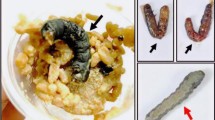Abstract
Six different geographical sources ofLymantria dispar (L.) andLymantria mathura (L.) in the People's Republic of China were sampled for nucleopolyhedrosis virus. Comparative bioassays of theL. dispar sources showed the U.S. Hamden standard to be more effective than the PRC nucleopolyhedrosis viruses. TheL. mathura NPV equalled the effectiveness of the Hamden standard even after 3 passages in lab rearedL. dispar larvae. This is the 1st report ofL. mathura NPV effect on a U.S. strain ofL. dispar.
Résumé
Six populations deLymantria dispar L. et desLymantria mathura L. provenant de différentes régions de République populaire de Chine furent examinées pour la présence de virus de la nucléopolyhédrose. Des essais comparatifs sur ces populations deL. dispar ont démontré que l'étalon de virus du “U.S. Hamden” est plus actif que ceux de la Chine. Le NPV deL. mathura, après passages successifs dans des larves en élevage en laboratoire fut également actif par rapport à l'étalon “Hamden” après le 3ème passage. Ceci est le premier rapport concernant l'effet du NPV deL. mathura contre une population deL. dispar d'origine américaine.
Similar content being viewed by others
References
Lewis, F.W., Rollinson, W & Yendol, W. — 1981. Gypsy moth nucleopolyhedrosis virus —laboratory evaluations. In: The Gypsy Moth: Research Toward Integrated Pest Management (Doane C.C. & Mcmanus M.L. ed.). —USDA Tech. Bull. 1584, 455–461.
Magnoler, A. — 1970. Susceptibility of gypsy moth larvae toLymantria spp. nuclear — and cytoplasmic — polyhedrosis virus. —Entomophaga, 15, 407–412.
Martignoni, M. &Iwai, P. — 1981. A catalogue of viral diseases of insects, mites, and ticks. In Microbial Control of Pests and Plant Diseases 1970–1980 (H.D. Burges: ed.). —Academic Press, N. Y., Lond., 897–911.
Podgwaite, J. & Campbell R. — 1971. Disease in natural gypsy moth populations. —Proc. 4th Int. Colloq. Insect Pathol., 279–284.
Rollinson, W. &Lewis, F.B. — 1973. Susceptibility of gypsy moth larvae toLymantria spp. nuclear and cytoptasmic polyhedrosis viruses. —Plant Prot., 24, (124–125), 163–168.
Ruperez, A. — 1973. Effectiveness ofLimantria dispar L. polyhedrosis viruses of different proveniences. —Plant Prot., 24 (124–125), 187–191.
Vasiljević, L. &Injać, M. — 1973. A study of gypsy moth viruses originating from different geographical regions. —Plant Prot., 24 (124–123), 169–189.
Author information
Authors and Affiliations
Rights and permissions
About this article
Cite this article
Lewis, F.B., Wallner, W.E. & Rollinson, W.D. Activity of lymantriid NPVS from the People's Republic of China against North AmericanLymantria Dispar . Entomophaga 29, 299–302 (1984). https://doi.org/10.1007/BF02372117
Issue Date:
DOI: https://doi.org/10.1007/BF02372117




